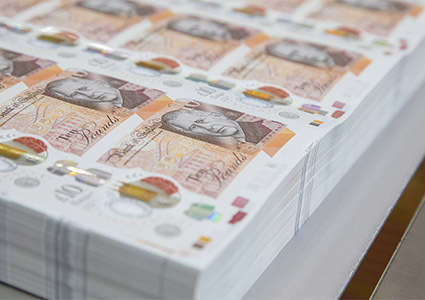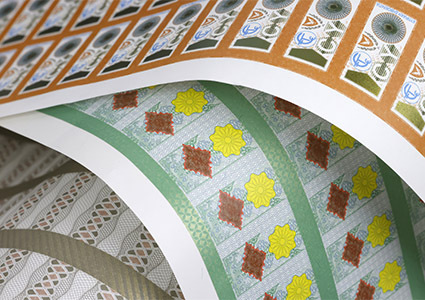Through innovation, De La Rue delivers secure solutions that stay ahead of illicit trade
As a leading provider of authentication and currency solutions, De La Rue offers secure digital and physical protection for goods, trade, and identities in 140 countries. With over 200 years of experience, the company boasts a culture of creativity and dedication to innovation through both long-term partnerships and new projects.
De La Rue’s solutions secure supply chains and cash cycles for governments, central banks, and businesses amid ever-increasing concerns of counterfeiting and illicit trade. The problem poses a significant threat to the public, businesses, and environment, with the US Patent and Trademark Office (USPTO) valuing the problem at somewhere between $1.7 trillion and $4.5 trillion each year – higher than drugs or human trafficking. 
The company’s product portfolio includes software platforms to protect the revenues and reputations of governments and businesses – supporting enforcement officers, preventing diversification of goods, and enabling governments to collect tax revenues. It also provides currency products and secure documents that physically protect supply chains and cycles, including physical brand protection tokens, polycarbonate ID bio-data pages and ID cards, tax stamps, banknotes, polymer banknote substrate, and currency security features.
We sit down with Terry Zammit, Manufacturing Director for the Currency Division, and Keith Eckford, Director of Global Operations, Authentication Division, to learn more about De La Rue’s global operations and constant innovation. While Terry heads up the manufacturing side of the currency business and has been with the business for 15 years, Keith is responsible for the authentication division operations, overseeing manufacturing, IT operations, global service and the latest innovations for the authentication portfolio.
“De La Rue has a very long and interesting history spanning 211 years,” Terry opens. “It started off as a print venture that quickly explored stationery, color printing, special edition newspapers, railway tickets, fountain and stylographic pens, then onto currency related printing. While we’ve always offered an element of printing services throughout history, our operations have since diversified into the manufacturing of secure products, namely, banknotes, security features, polymer substrate, brand protection and government revenue solutions, financial and security documents, ID security components and software platforms to govern and protect these solutions.”
Keith adds: “One of the facts I like to tell people we introduce to De La Rue is that we designed, developed and installed the UK’s first ATM machine in London. Fundamentally, we sell security, not only in the products we produce like tax stamps and polycarbonate data pages, but also security of information, relationships, and design. Whether we’re working with governments, brands, or authorities, trust and integrity are paramount to successful and accurate delivery of our products, services and solutions.
 “There are several synergies between the two divisions, especially because a large part of the authentication side is what we call government revenue solutions (GRS), which utilizes some of the same security printing processes as those used by the currency division led by Terry. GRS sees us provide full services to governments to enable their tax schemes, whether it’s tobacco, alcohol, or soft drinks.
“There are several synergies between the two divisions, especially because a large part of the authentication side is what we call government revenue solutions (GRS), which utilizes some of the same security printing processes as those used by the currency division led by Terry. GRS sees us provide full services to governments to enable their tax schemes, whether it’s tobacco, alcohol, or soft drinks.
“We not only produce a physical marker to authenticate items, but we run the entire scheme from a software perspective, providing 24/7 service coverage across the globe. We’re well equipped to deliver high availability systems that require calls to be answered within five seconds and a software 99.9 percent availability, as well as shipping orders within 24 hours of receiving them.
“Having worked with central banks and governments on the currency side for several years, these connections have helped foster strong working relationships with such organizations in the authentication division. In terms of operations, Terry and I have worked closely for many years, and we cross train our employees to ensure flexibility and resilience across all divisions. We’re one of the minority of commercial entities to hold ISO 22301:2019 in Business Continuity and hold it across all of our sites.
“We also collaborate on research and development (R&D), especially for projects that require expertise from both divisions,” Keith continues. “We might need assistance with platform innovation technologies, for instance, or the currency team would require our help when working on a new feature for an optical holographic. We’re constantly evaluating the ways in which we can work together to develop and deliver innovative products in various markets.”
Having taken over product development for authentication just six months ago, Keith is keen to tell us about the latest developments in the area. “We continually challenge ourselves to try and copy or simulate the products or features we’re developing to ensure they cannot be replicated,” he explains. “We use basic methods and small-scale technology, as well as complex or sensitive machinery to evaluate how difficult our products are to copy. This not only makes our products more resilient, but also informs the next wave of potential features.
“We’ve recently worked with Microsoft to launch Spotlight™, a certificate of authenticity comprising a hologram type product, which appears as a simple shiny block, but shining a torch on it reveals movement within the hologram. This new concept means interacting with the feature through torchlight or a camera, as opposed to verifying a product by simply looking at it. I expect to see increased demand for such interactive systems over the next 12-to-18 months, especially as brands and organizations continue to look for more resilient solutions.”
Keith comments: “We’re working on a similar concept in the polycarbonate and ID space, where a torchlight shone behind the page reveals a hidden portrait embedded into the various layers of the ID page. We’re not only developing IP technology, but also the specific equipment to develop what is one of the most secure polycarbonate data pages in the world.”
Terry explains: “We’re expanding both our capacity and capabilities in Malta, with a huge expansion project to correlate with the site’s 50th anniversary. The expansion will create a new, state-of-the-art facility for both the currency and authentication divisions, which will almost double our existing footprint. We’re currently able to produce over 14 billion different products at our site in Malta, but we’re adding new machinery, features, and capabilities to provide an extensive range of options at a variety of price points.”
As our conversation draws to a close, Terry and Keith reflect on the current markets and how they’re planning to take De La Rue to new heights. “While there are conversations around reducing currency in our current markets, there will always be demand for currency, and we believe that our expertise will enable us to continue delivering innovative solutions to stay ahead of the market,” Keith suggests. Globally cash in circulation continues to grow at five percent annually and cash remains the number one method of payment in many of the countries in which De La Rue operates. “From an authentication perspective, I see the GRS space growing significantly, as it supports government revenues and reduces illicit trade to bring more tax into the economies.
“We currently run tax schemes for tobacco, alcoholic drinks, and soft drinks, but we’re involved in ongoing conversations over pilot projects or expanding into other geographies,” he reveals. “Outside of our current markets, we’ve had discussions about cosmetics, electronics, and even cheese! As part of a dynamic, fast-moving market, we’ll continue our journey over the coming years to ensure we continually meet the evolving needs of our clients.”
Within currency, on the other hand, Terry adds: “We’ll continue our focus on polymer currency production, with designs and innovative additions that offer a sustainable alternative to paper currency. Across a banknote lifetime, polymer produces 60 percent waste and uses 96 percent less water, compared to the equivalent paper banknote substrates. We must keep expanding while pushing our cost base down to enhance our efficiencies, capabilities, and performance, ensuring we remain competitive in the market, and close to our customers’ needs with our offerings and solutions.
“We will continue to improve our assets’ capabilities and efficiencies across all our sites, and more importantly invest in people as we grow within both divisions,” he concludes. “We won’t stand still; we will keep pushing ourselves to retain, nurture and grow what we have worked so hard for and achieved over the last 200 years, whilst also taking advantage of the growing need for solutions that work across digital and physical interfaces.”
